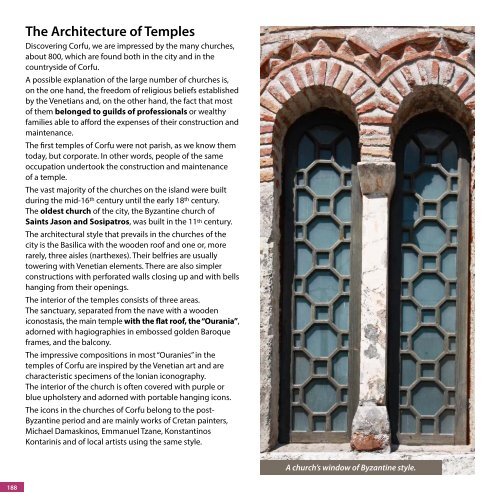You also want an ePaper? Increase the reach of your titles
YUMPU automatically turns print PDFs into web optimized ePapers that Google loves.
The Architecture of Temples<br />
Discovering Corfu, we are impressed by the many churches,<br />
about 800, which are found both in the city and in the<br />
countryside of Corfu.<br />
A possible explanation of the large number of churches is,<br />
on the one hand, the freedom of religious beliefs established<br />
by the Venetians and, on the other hand, the fact that most<br />
of them belonged to guilds of professionals or wealthy<br />
families able to afford the expenses of their construction and<br />
maintenance.<br />
Τhe first temples of Corfu were not parish, as we know them<br />
today, but corporate. In other words, people of the same<br />
occupation undertook the construction and maintenance<br />
of a temple.<br />
The vast majority of the churches on the island were built<br />
during the mid-16 th century until the early 18 th century.<br />
The oldest church of the city, the Byzantine church of<br />
Saints Jason and Sosipatros, was built in the 11 th century.<br />
The architectural style that prevails in the churches of the<br />
city is the Basilica with the wooden roof and one or, more<br />
rarely, three aisles (narthexes). Their belfries are usually<br />
towering with Venetian elements. There are also simpler<br />
constructions with perforated walls closing up and with bells<br />
hanging from their openings.<br />
The interior of the temples consists of three areas.<br />
The sanctuary, separated from the nave with a wooden<br />
iconostasis, the main temple with the flat roof, the “Ourania”,<br />
adorned with hagiographies in embossed golden Baroque<br />
frames, and the balcony.<br />
The impressive compositions in most “Ouranies” in the<br />
temples of Corfu are inspired by the Venetian art and are<br />
characteristic specimens of the Ionian iconography.<br />
The interior of the church is often covered with purple or<br />
blue upholstery and adorned with portable hanging icons.<br />
The icons in the churches of Corfu belong to the post-<br />
Byzantine period and are mainly works of Cretan painters,<br />
Michael Damaskinos, Emmanuel Tzane, Konstantinos<br />
Kontarinis and of local artists using the same style.<br />
A church’s window of Byzantine style.<br />
188



